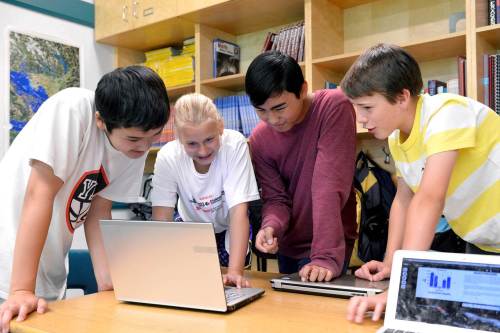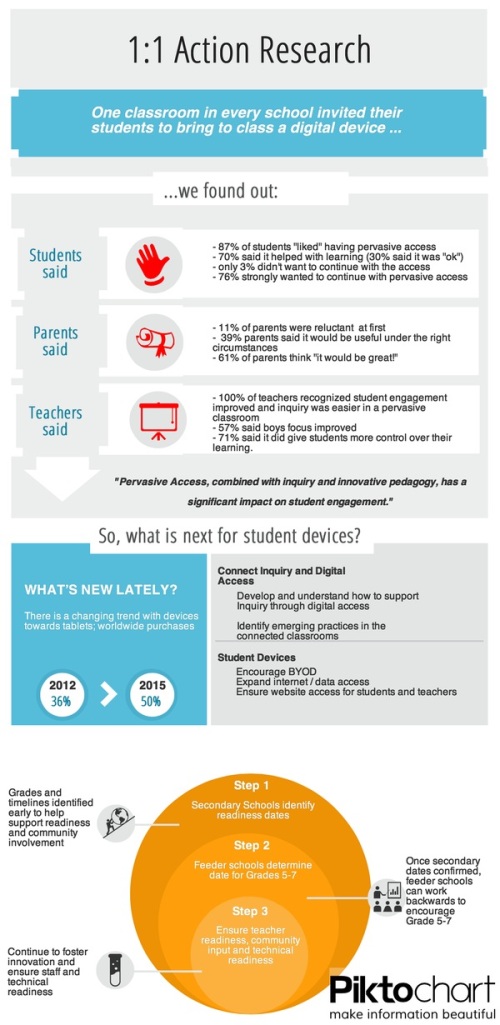In some ways, this is a follow-up or companion piece to my post last week when teachers have mobile devices in the classroom, on our findings and efforts to ensure digital access for all of our teachers.
While this has proven to be very powerful for teachers, our next step is around finding access for all students. In a previous post, I shared some thoughts around BYOD and Equity (an issue I think is crucial when looking at getting devices into students’ hands).
In West Vancouver, student access is growing; in some elementary schools students have regular access mainly from devices they bring from home. In other schools it is less consistent with pockets of classrooms having students on devices. One key piece of learning we have realized over the last three years is if students don’t have purposeful reasons to use their device in class they will often stop bringing it.
So, before one announces that “everyone will bring a laptop on Monday” there are ways to work toward changing and improving that experience. The challenges around the recent iPad rollout in Los Angeles schools are a good reminder of the complexity of these kinds of initiatives.
So, what we did rather than focusing on embracing devices and changing practice for the entire year, was to focus on trying it with support for a two- to three-week period. We tried this last spring and have plans to do it again this fall.
Here is a brief overview of the project:
There is increasing support that access to digital resources and tools combined with inquiry teaching and learning practices improves student engagement, learning relevancy and academic success. A challenge in today’s classroom is the inconsistent access to digital tools: some students have access some of the time, some have no access and only a few students have access all of the time. Building on the opportunities from the recent Modernization initiative, the Digital Access Action Research project is aimed at understanding the impact of “ubiquitous” or pervasive student access on learning and teaching.
The Digital Access Action Research project is looking for interested Grades 4 to 9 classrooms willing to try “ubiquitous access” for a two- to three-week period. This would include:
- Sending home a district letter to all parents asking them to provide a digital device for their students during that period. The device can be an iPad or a laptop. For those who do not have a spare device at home, the district will provide a device the student can use during the project.
- Attending a morning session (TTOC included for teachers) prior to the start of the project to plan for the action research and to determine how best to utilize the opportunity that every student will have digital access whenever and wherever they need it.
- Ensuring the students use the device when appropriate during the school day and to have the device taken home at the end of the day
- Completing a follow-up summary around lessons learned and challenges from the project. This will provide a better understanding of the opportunities available through digital access as well as what challenges we continue to face.
There are many details to consider with this project, including:
- When the students should and shouldn’t use the devices
- How to shape the learning activities to benefit most from the digital access and minimize distractions
- How to secure the devices when not being used
- How to problem solve technical problems and challenges
If we want to move towards digital access for students, it is not a proclamation of change — even if students bring devices, very little in the classroom may change. That is why our thinking around this is although some classes and schools are full speed ahead, in other situations we need to scaffold this change and start with projects like this action research.
So, here is what we found:
Director of Instruction, Gary Kern, has also blogged more about these findings here. There is not a ‘one size fits all’ model around our work. In fact, this particular project has shown that sometimes, before we make big changes, we have to take some smaller steps. Before we say all students need to bring devices for the year, let’s try it for three or four weeks; before we say that teachers need to change their practice to embrace the digital landscape, let’s support them through doing it for a unit. And, we were also reminded the power of digital access is its interplay with inquiry and innovative pedagogy.
Many of the classes that were part of this trial in the spring have moved to having students bring devices all the time this fall — it is a bit of a continuum. It is great to say that “all our students have devices” but if nothing else has changed what really is the point? It will be interesting to see our next group of action researchers take up the challenge this fall.




